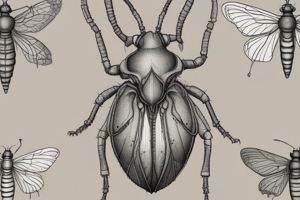Podcast
Questions and Answers
What is the primary method used to classify insects?
What is the primary method used to classify insects?
- Morphology, physiology, and phylogeny (correct)
- Behavioral traits
- Geographic distribution only
- Color and size alone
Which of the following is a component of Integrated Pest Management (IPM)?
Which of the following is a component of Integrated Pest Management (IPM)?
- Ignoring crop rotation practices
- Complete elimination of all pests
- Using only chemical pesticides
- Introducing natural enemies or parasites (correct)
Which of the following poses a direct threat to insect populations?
Which of the following poses a direct threat to insect populations?
- Habitat loss and climate change (correct)
- Increased biodiversity
- Pollination activities
- Conservation efforts
What is the significance of insects in ecosystems?
What is the significance of insects in ecosystems?
Which type of control involves modifying agricultural practices?
Which type of control involves modifying agricultural practices?
What is the main role of insects in ecosystems?
What is the main role of insects in ecosystems?
Which body part of an insect is responsible for housing the digestive organs?
Which body part of an insect is responsible for housing the digestive organs?
What type of circulatory system do insects possess?
What type of circulatory system do insects possess?
Which of the following insect orders includes butterflies and moths?
Which of the following insect orders includes butterflies and moths?
What is the main purpose of the Malpighian tubules in insects?
What is the main purpose of the Malpighian tubules in insects?
How do insects primarily communicate with each other?
How do insects primarily communicate with each other?
What is a common feature that distinguishes insect bodies?
What is a common feature that distinguishes insect bodies?
Which of the following behaviors indicates complex organization in social insects?
Which of the following behaviors indicates complex organization in social insects?
Flashcards
Entomology
Entomology
The scientific study of insects.
Insect Body Segments
Insect Body Segments
Insects have three body parts: head, thorax, and abdomen.
Insect Legs
Insect Legs
Insects have three pairs of legs.
Insect Exoskeleton
Insect Exoskeleton
Signup and view all the flashcards
Insect Respiration
Insect Respiration
Signup and view all the flashcards
Insect Metamorphosis
Insect Metamorphosis
Signup and view all the flashcards
Insect Orders
Insect Orders
Signup and view all the flashcards
Insect Roles in Ecosystem
Insect Roles in Ecosystem
Signup and view all the flashcards
Insect Classification
Insect Classification
Signup and view all the flashcards
Integrated Pest Management (IPM)
Integrated Pest Management (IPM)
Signup and view all the flashcards
Insect Conservation
Insect Conservation
Signup and view all the flashcards
Insect Identification
Insect Identification
Signup and view all the flashcards
Biological Control
Biological Control
Signup and view all the flashcards
Study Notes
Introduction to Entomology
- Entomology is the scientific study of insects.
- Insects are a diverse group of invertebrates, belonging to the phylum Arthropoda.
- They are characterized by three body segments (head, thorax, abdomen), three pairs of legs, and usually two pairs of wings.
- Insects play crucial roles in ecosystems, acting as pollinators, decomposers, and prey.
- They can also transmit diseases, damage crops, and be pests.
Insect Morphology
- Insect bodies are segmented, providing flexibility and support.
- Exoskeleton: a hard, protective outer covering made of chitin.
- Head: bears sensory organs (antennae, eyes), mouthparts adapted for different feeding strategies (chewing, sucking, piercing).
- Thorax: bears three pairs of legs and wings (when present).
- Abdomen: houses digestive, reproductive, and excretory organs.
Insect Physiology
- Respiration: through tracheal tubes (a system of air-filled tubes).
- Circulation: open circulatory system (hemolymph).
- Excretion: through Malpighian tubules.
- Nervous system: consists of a central brain and a ventral nerve cord.
- Reproduction: most insects undergo metamorphosis (complete or incomplete).
Insect Diversity
- Insects exhibit incredible diversity in form, function, and behavior.
- Orders of insects include Coleoptera (beetles), Lepidoptera (butterflies and moths), Hymenoptera (ants, bees, wasps), Diptera (flies), and Orthoptera (grasshoppers and crickets).
- Each order has specific characteristics and adaptations enabling them to occupy diverse ecological niches.
Insect Ecology
- Importance in food webs: acting as both prey and predators.
- Pollination: many insects are crucial pollinators of plants, facilitating seed production.
- Decomposition: insects play a critical role in decomposing organic matter.
- Impact on agriculture: some insects are considered pests due to crop damage, while others are beneficial as biological control agents.
Economic Importance of Insects
- Insect pests impact crop yields and cause significant economic losses.
- Beneficial insects can be used in biological pest control methods.
- Insects are important in the food industry (e.g., honey production, silk production).
Insect Behavior
- Communication: chemical signals (pheromones), visual cues.
- Defense mechanisms: camouflage, mimicry, chemical defenses.
- Social behavior: some insect societies exhibit complex organization.
- Reproduction strategies: mating behaviors, parental care.
Insect Classification and Taxonomy
- Insects are classified based on their morphology, physiology, and phylogeny.
- Classification systems use hierarchical categories (kingdom, phylum, class, order, family, genus, species).
- Identification keys are used to distinguish between different insect species.
Insect Control and Management
- Integrated Pest Management (IPM): a sustainable approach to controlling insect pests.
- Pesticides: chemicals used to control insect populations.
- Biological control: introducing natural enemies or parasites of the pest insects.
- Cultural control: modifying agricultural practices to reduce pest populations.
Conservation of Insects
- Insects are facing threats from habitat loss, climate change, and pollution.
- Conservation efforts are needed to protect these vital components of ecosystems.
- Recognizing the importance of insects in pollination and decomposition are key aspects of ecological preservation.
Studying That Suits You
Use AI to generate personalized quizzes and flashcards to suit your learning preferences.




